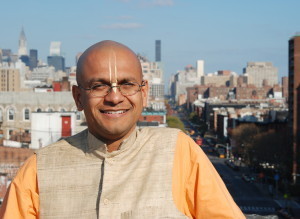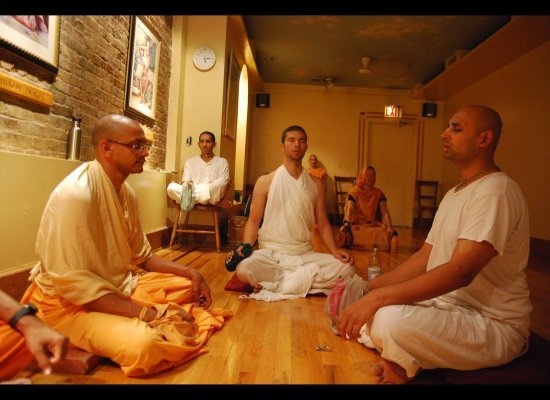 Gadadhara Pandit Dasa at the Huffington Post
Gadadhara Pandit Dasa at the Huffington Post Most people I encounter are quite fascinated by the idea of monks living in Manhattan. I suppose the fascination is quite natural. Most people engaged in monastic life are expected to live away from a busy city. A place that allows for focused meditation and reflection on spiritual life. Wouldn't a busy city like New York, which is seen by many as the height of materialism, seem quite counterproductive to the monastic life?
It all depends on one's purpose. If one is aspiring to focus only on one's own individual meditation and spiritual practice, then a busy city environment can definitely be counterproductive. However, if one is residing in a city for the purpose of helping people, then there's no better place.
Within the Bhakti tradition of Hinduism, the tradition that I have adopted, it is recommended that some monks live in the city because that's where people are most stressed and therefore need the most spiritual guidance. The city is a very intense place where everyone is constantly scrambling from one activity to another, always keeping themselves busy, often times leaving their spiritual pursuits by the wayside.
The Bhakti tradition teaches that making oneself available to assist others helps one develop greater levels of compassion, which is a very important tenet of Hinduism. This tenet applies to monks and laypersons.
The city can actually push one to greater levels of focus in one's meditation. There are so many distractions everywhere and to prevent oneself from getting sucked into the ubiquitous materialism, one really needs to take greater shelter of the meditation and other focusing practices.
For example, when you're driving at high speeds, you need to be more attentive, otherwise the chances of an accident are much greater. I like to compare the city to a high-speed highway which requires a greater level of focus.
Being a monk in New York City can definitely be challenging. I'm more comfortable in a city environment than some of our monks. I was born in Kanpur, which is an extremely busy, industrial city. Then, at the age of about five, we moved to New Delhi, which is also insanely busy. By age seven, I was living in Los Angeles.
When I first moved to New York, I found it to be an exciting place. Because of my conditioning, I like busy places. People, cars, trucks, and other city noises don't really bother me. I do like to get away once in a while, but for the most part, I'm fine with it.
The monastery, located in the Lower East Side, is right on First Avenue, and from the outside, it looks like just another New York brownstone, so one could walk right past it and not notice anything special. We're surrounded by bars, nightclubs, restaurants, tattoo shops, and a variety of eclectic establishments. It's probably one of the busiest areas in Manhattan on Friday and Saturday nights. The action actually starts on Thursday nights and goes until early Sunday morning till about 4:00 a.m.
I know the timings so well because I usually wake up at 4:00 a.m. and can hear the boisterous discussions taking place on the avenue after the bars have closed and flushed out their clients. Once, I even saw a couple of guys with their shirts off, in a total drunken stupor, having a fist fight right in the middle of the street. It's quite a scene out there with people yelling and bottles smashing against the sidewalk.
The natural question arises: What in the world are monks doing in a place like this?!
There's about 15 of us and we all wake up between 4:00 a.m. and 4:30 a.m. Our morning meditation starts at 5:00 a.m. To refresh ourselves from the night's sleep, everyone is required to shower, put on a clean set of robes and then enter the temple room for the meditation and worship. According to the teachings in Hinduism, the mind has the easiest time focusing during the early morning hours. The mind responds to all the stimuli around us -- people, traffic, noises, and activity in general. There's not a whole lot of activity going on at 4:30am. Stilling the mind is close to impossible, but the morning hours do help when you're trying to focus the mind.
Our morning services move through a variety of moods and flavors. We start with the more grave mantra meditation and after an hour, we move into a very devotional practice of song and devotional dance. We sing different songs glorifying the previous teachers and God. The use of traditional Indian instruments such as cartals (cymbals) and a double-sided Bengali drum allow the sessions to become quite rhythmic and ecstatic. The beautiful melodies enable one to pour their heart into the prayers being sung while all the monks move back and forth and side to side and eventually dance in a circle. It's an incredibly powerful, devotional, and spiritual way to start the morning. It's easily more energizing than a double espresso and the experience stays with you the entire day.
The monks rotate lecturing from Hindu scripture elucidating the philosophy and explaining how it can be applied into our daily lives. During the lecture part of the morning program, some of the other monks are taking notes on the class, while others are cutting up vegetables for the day's cooking and some are stringing garlands of fresh flowers to be offered on the altar.
Whenever anyone hears about the morning service, a common question arises "how often do you guys do this?" and I tell them "everyday -- seven days a week." The look on most people's face is priceless when they hear my answer. It's anything but boring. There's quite a bit going on and the three hours, from 5:00 a.m. to 8:00 a.m., flies by. Of course, if you haven't had a good night's rest, it can get kind of rough at times. After the morning program and before breakfast at 9:00 a.m., some monks will continue to do additional meditation, while others will do some yoga, and some may even take a quick nap.
The morning meditation and prayer service is our food for the soul. It gives us the much needed nourishment we need to handle the madness of the city and it gives us the spiritual strength we need for our various activities -- teaching, counseling, lecturing, cooking, cleaning, and going out to engage with the local population.
Being a monk in New York isn't easy by any means, however, if the principle of service to humanity is adhered to, it can be very satisfying and even blissful. Due to length constraints, I am only able to describe the first five hours of our day. In a future piece, I will go into further details of our monastic life, which will reveal more about the inner workings of the monastery and some of the challenges the monks face, individually and collectively.
Follow Gadadhara Pandit Dasa on Twitter: www.twitter.com/nycpandit


